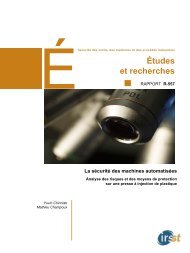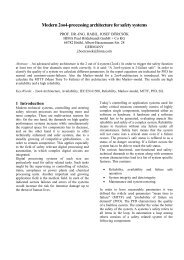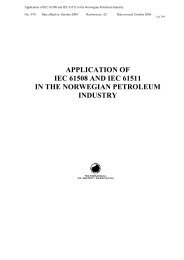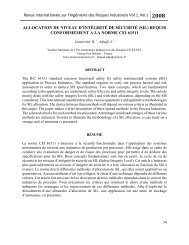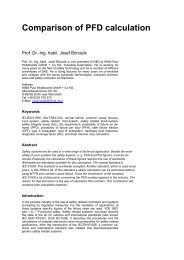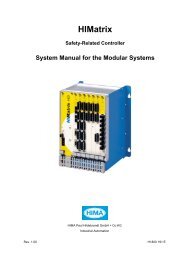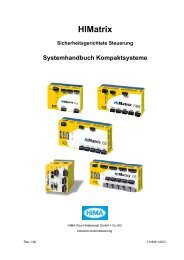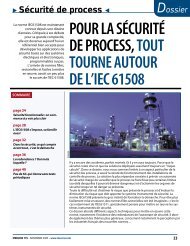Functional Safety
Functional Safety
Functional Safety
Create successful ePaper yourself
Turn your PDF publications into a flip-book with our unique Google optimized e-Paper software.
White Paper<br />
Tino Vande Capelle, Dr. M.J.M. Houtermans<br />
<strong>Functional</strong> <strong>Safety</strong>: A Practical Approach<br />
for End-Users and System Integrators<br />
Item<br />
Table 6 Hardware Checklist<br />
Applicable standard<br />
Type<br />
Hardware fault tolerance<br />
Safe failure fraction<br />
Safe detected failure rate<br />
Safe undetected failure rate<br />
Dangerous detected failure rate<br />
Dangerous undetected failure rate<br />
SIL level for which the product is fit for use<br />
Recommends periodic proof test interval<br />
With this information the end-user or system integrator can easily determine how to comply<br />
with the architectural constraints tables and build the architecture of their loop as desired.<br />
This information can be delivered by the supplier itself, through a third party report or<br />
through a certification report. It is up to the end-user to decide what is actually required<br />
(read what can be trusted). The architecture needs to be redesigned until the architectural<br />
constraints requirements are met.<br />
5. THE ROLE OF RELIABILITY ANALYSIS<br />
Once the architectural system design of the safety loop complies with the architectural<br />
constraints tables the loop has met already one of the most important requirements of the<br />
standards. Another important requirement is the probability of failure on demand (PFD) or<br />
continuous mode (PFH) calculation. This is the probability that the safety function cannot be<br />
carried out upon demand from the process. It needs to be calculated for those processes<br />
where the expected demand is less than once per year. If a loop is used in a continuous<br />
mode then it is necessary to calculate the frequency of failure of this loop per hour. This is<br />
necessary as we now are in a different situation. Where the demand loop can only cause a<br />
problem when there is an actual demand from the process the continuous loop can actual<br />
be the cause of a process upset when the loop itself has failed. Table 7 gives an overview of<br />
the required probabilities and frequencies per SIL level.<br />
Table 7 PFD versus PFH<br />
Demand Mode Continuous Mode<br />
SIL Probability of failure on demand Frequency of the failure per hour<br />
4 ≥ 10 -5 to < 10 -4 ≥ 10 -9 to < 10 -8<br />
3 ≥ 10 -4 to < 10 -3 ≥ 10 -8 to < 10 -7<br />
2 ≥ 10 -3 to < 10 -2 ≥ 10 -7 to < 10 -6<br />
1 ≥ 10 -2 to < 10 -1 ≥ 10 -6 to < 10 -5<br />
HIMA <strong>Functional</strong> <strong>Safety</strong> Consulting Services Page 15



